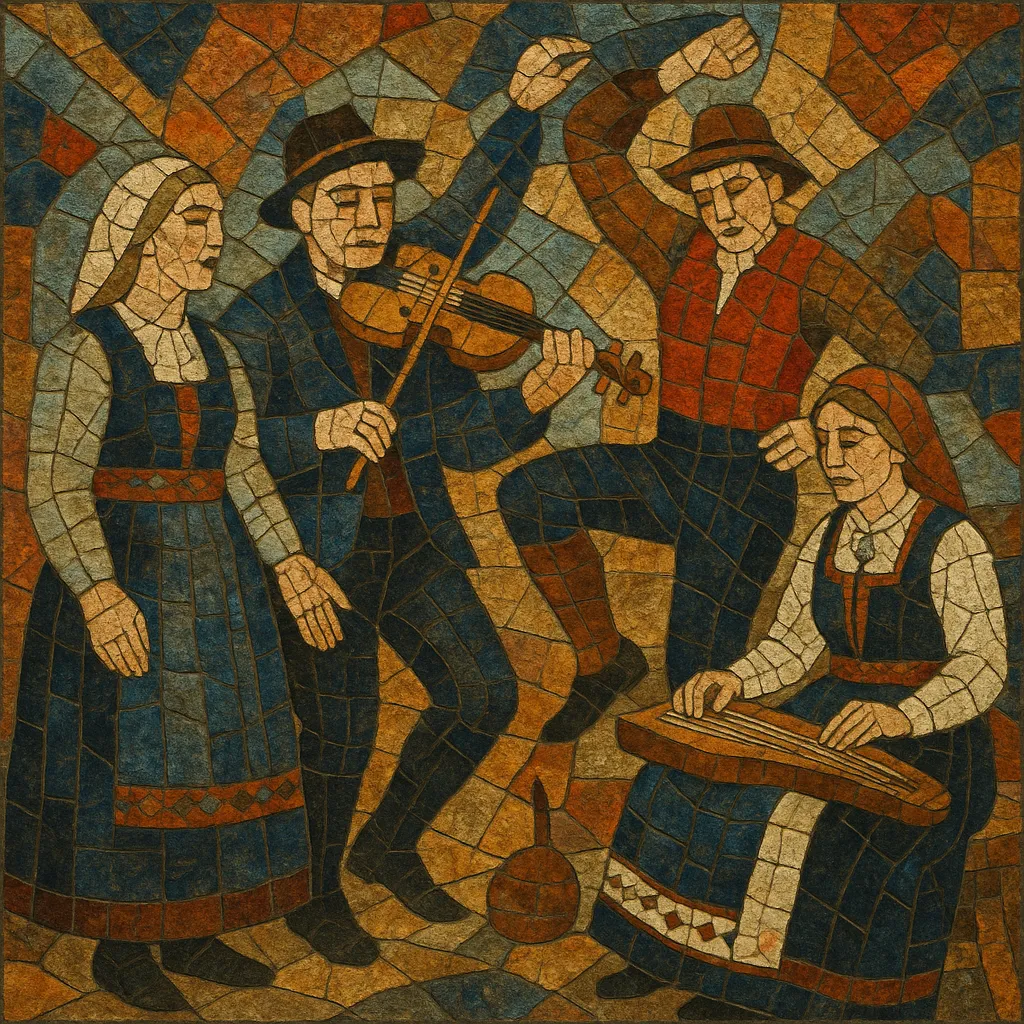Norwegian folk music is a regional tradition centered on the Hardanger fiddle (Hardingfele), kveding (traditional solo song), and a family of couple- and solo-dances such as springar, gangar, halling, and pols. It uses modal melodies (often Dorian and Mixolydian), drones, and distinctive asymmetric triple meters in which the three beats are of unequal length.
Characteristic instruments include the Hardanger fiddle with sympathetic strings and scordatura tunings, standard fiddle, langeleik (zither), seljefløyte (willow flute), wooden lur, bukkehorn (goat horn), munnharpe (jaw harp), and later accordion. Vocal genres range from short, epigrammatic stev to medieval ballads and free, ornamented kveding styles. Ornamentation, double-stops, drones, and dance-driven bowing patterns are core to the sound.
The repertoire is organized into slåtter (tunes) linked to particular dances and regions, carrying strong local identities (bygdedans). While deeply rooted in rural tradition, it has continually evolved through collectors, revivals, and collaborations with jazz, classical, and contemporary folk scenes.
Norwegian folk song traditions reach back to the medieval period through narrative ballads and work- and ritual-songs, while dance and instrumental practices crystallized in rural communities. By the 1600s, the Hardanger fiddle emerged in western Norway, adding sympathetic strings and region-specific tunings that shaped a unique sound. Continental court dances and Baroque influence (via polonaise/polska families) filtered into local styles and were reinterpreted as bygdedans.
Throughout the 18th and 19th centuries, distinct regional idioms formed (Telemark, Hallingdal, Valdres, Hardanger). Slått repertoires (springar-, gangar-, halling-slåtter) became closely tied to social dance. The national romantic movement spurred collecting and documentation; figures such as Ludvig Mathias Lindeman preserved songs, while performers like Myllarguten popularized the Hardanger fiddle, and composers such as Edvard Grieg drew on folk idioms in art music.
The early 20th century saw continued regional transmission alongside new media (radio/recordings) that broadened audiences. Folk performers and scholars codified styles, competitions, and festivals, supporting continuity. Post–1960s folk revivals brought renewed interest, instrument-making, pedagogy, and stage ensembles, while the accordion and later hybrid projects expanded textures.
From the 1990s onward, Norwegian folk interfaced with contemporary jazz, classical, and global folk, yielding collaborations and innovative arranging. The tradition remains dance- and locality-centered, yet thrives on modern stages and recordings. Today, leading fiddlers, kvedarar (singers), and ensembles sustain lineage while composing new slåtter and evolving the idiom.
Start with Hardanger fiddle if available; otherwise use standard fiddle with drone-friendly tunings. Employ scordatura (cross-tuning) so open strings ring as drones, and let sympathetic strings (on Hardanger fiddle) enhance sustain and shimmer. Add langeleik, jaw harp, bukkehorn, or seljefløyte for color; accordion can double or punctuate dance beats.
Write slåtter tied to dances: springar (asymmetric 3-time with uneven beat lengths), gangar (duple, walking feel), halling (vigorous solo dance), and pols/polska-derived forms. Keep phrases modular and danceable, with repeat structures and slight regional variants. Use a strong, loping pulse and bowing patterns that emphasize lift and swing rather than strict metronomic time.
Compose in modal scales (Dorian, Mixolydian, Aeolian) with a limited tonal palette, highlighting drones and open strings. Favor double-stops, pedal tones, and neighboring-note ornaments (trills, mordents, slides) integral to fiddle style. Harmony is sparse: rely on drones and implied harmony from melodic motion; when arranging, add parallel fifths or simple tonic–dominant pedal layers rather than dense chords.
Embed grace notes, crushed ornaments, and bow articulation specific to each dance. Let phrases breathe; slight rubato and microtiming are acceptable, especially in song or listening slåtter (lyarslåtter). Keep cadences clear for dancers, but allow melodic variation on repeats.
For kveding and stev, write compact stanzas with vivid imagery, aphorisms, or narrative fragments. Use flexible, speech-like rhythm with ornamented melismas. Ballad-style texts can be longer and strophic; keep refrains simple and memorable.
When arranging for ensemble, center the fiddle, add rhythmic stomp or frame drum subtly, and layer langeleik or accordion for timbre. Maintain head–variation–head forms, and let each repeat introduce small melodic or bowing changes to mirror traditional performance practice.


